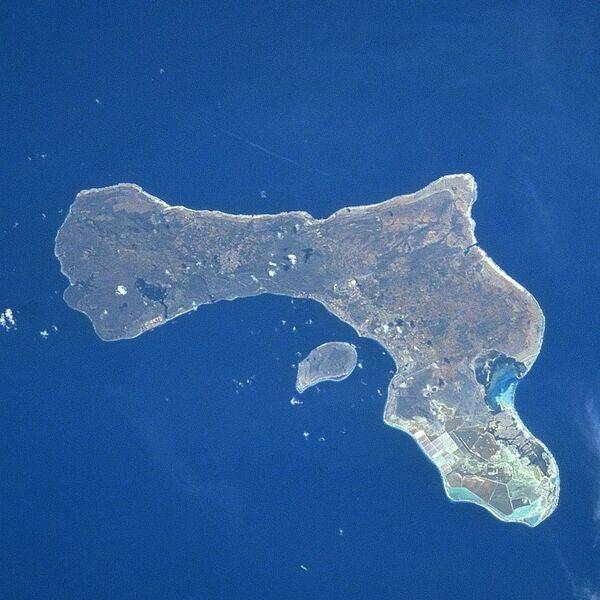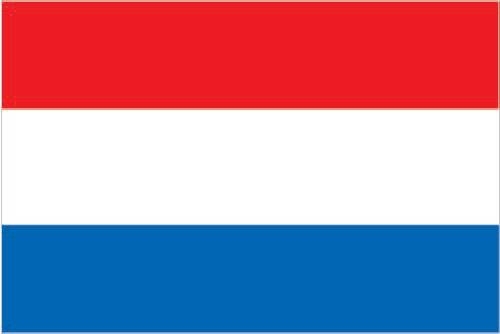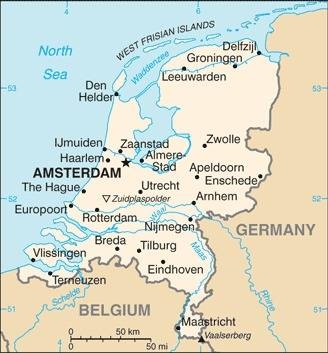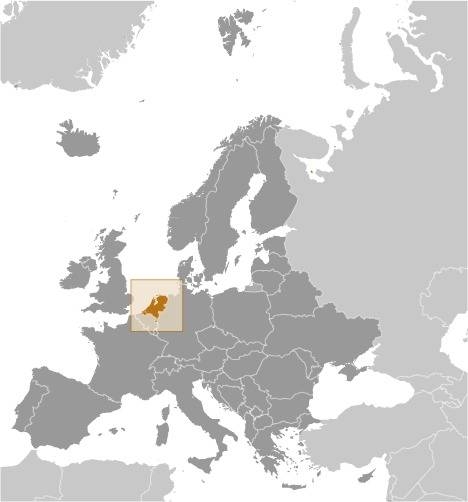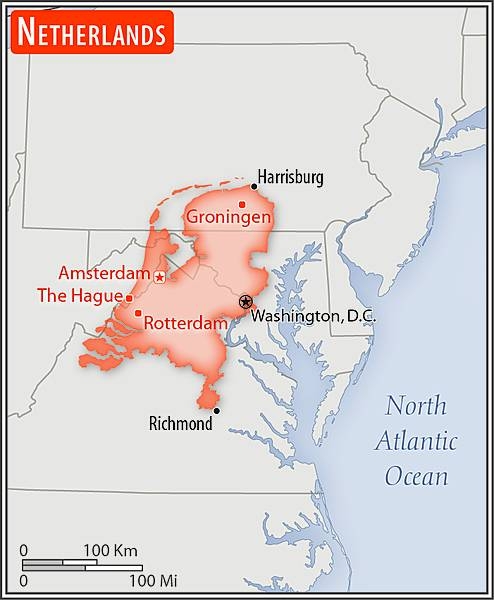Netherlands
Introduction
Background
The Dutch United Provinces declared their independence from Spain in 1579; during the 17th century, they became a leading seafaring and commercial power, with settlements and colonies around the world. After a 20-year French occupation, a Kingdom of the Netherlands was formed in 1815. In 1830, Belgium seceded and formed a separate kingdom. The Netherlands remained neutral in World War I but suffered German invasion and occupation in World War II. A modern, industrialized nation, the Netherlands is also a large exporter of agricultural products. The country was a founding member of NATO and the EEC (now the EU) and participated in the introduction of the euro in 1999. In October 2010, the former Netherlands Antilles was dissolved and the three smallest islands - Bonaire, Sint Eustatius, and Saba - became special municipalities in the Netherlands administrative structure. The larger islands of Sint Maarten and Curacao joined the Netherlands and Aruba as constituent countries forming the Kingdom of the Netherlands.
In February 2018, the Sint Eustatius island council (governing body) was dissolved and replaced by a government commissioner to restore the integrity of public administration. According to the Dutch Government, the intervention will be as "short as possible and as long as needed."
Visit the Definitions and Notes page to view a description of each topic.
Geography
Location
Western Europe, bordering the North Sea, between Belgium and Germany
Geographic coordinates
52 31 N, 5 46 E
Map references
Europe
Land boundaries
total: 1,053 km
border countries (2): Belgium 478 km; Germany 575 km
Coastline
451 km
Maritime claims
territorial sea: 12 nm
contiguous zone: 24 nm
exclusive fishing zone: 200 nm
Climate
temperate; marine; cool summers and mild winters
Terrain
mostly coastal lowland and reclaimed land (polders); some hills in southeast
Elevation
highest point: Mount Scenery (on the island of Saba in the Caribbean, now considered an integral part of the Netherlands following the dissolution of the Netherlands Antilles) 862 m
lowest point: Zuidplaspolder -7 m
mean elevation: 30 m
note: the highest point on continental Netherlands is Vaalserberg at 322 m
Natural resources
natural gas, petroleum, peat, limestone, salt, sand and gravel, arable land
Land use
agricultural land: 55.1% (2018 est.)
arable land: 29.8% (2018 est.)
permanent crops: 1.1% (2018 est.)
permanent pasture: 24.2% (2018 est.)
forest: 10.8% (2018 est.)
other: 34.1% (2018 est.)
Irrigated land
2,969 sq km (2019)
Major rivers (by length in km)
Rhine river mouth (shared with Switzerland [s], Germany, and France) - 1,233 km
note – [s] after country name indicates river source; [m] after country name indicates river mouth
Major watersheds (area sq km)
Atlantic Ocean drainage: Rhine-Maas (198,735 sq km)
Population distribution
an area known as the Randstad, anchored by the cities of Amsterdam, Rotterdam, the Hague, and Utrecht, is the most densely populated region; the north tends to be less dense, though sizeable communities can be found throughout the entire country
Natural hazards
flooding
volcanism: Mount Scenery (887 m), located on the island of Saba in the Caribbean, last erupted in 1640;; Round Hill (601 m), a dormant volcano also known as The Quill, is located on the island of St. Eustatius in the Caribbean;; these islands are at the northern end of the volcanic island arc of the Lesser Antilles that extends south to Grenada
Geography - note
located at mouths of three major European rivers (Rhine, Maas or Meuse, and Scheldt); about a quarter of the country lies below sea level and only about half of the land exceeds one meter above sea level
People and Society
Nationality
noun: Dutchman(men), Dutchwoman(women)
adjective: Dutch
Ethnic groups
Dutch 75.4%, EU (excluding Dutch) 6.4%, Turkish 2.4%, Moroccan 2.4%, Surinamese 2.1%, Indonesian 2%, other 9.3% (2021 est.)
Languages
Dutch (official); note - Frisian is an official language in Fryslan province; Frisian, Low Saxon, Limburgish, Romani, and Yiddish have protected status under the European Charter for Regional or Minority Languages; Dutch is the official language of the three special municipalities of the Caribbean Netherlands; English is a recognized regional language on Sint Eustatius and Saba; Papiamento is a recognized regional language on Bonaire
major-language sample(s):
Het Wereld Feitenboek, een onmisbare bron van informatie. (Dutch)
The World Factbook, the indispensable source for basic information.
Religions
Roman Catholic 20.1%, Protestant 14.8% (includes Dutch Reformed, Protestant Church of The Netherlands, Calvinist), Muslim 5%, other 5.9% (includes Hindu, Buddhist, Jewish), none 54.1% (2019 est.)
Age structure
0-14 years: 16.11% (male 1,425,547/female 1,358,894)
15-24 years: 11.91% (male 1,049,000/female 1,008,763)
25-54 years: 38.47% (male 3,334,064/female 3,313,238)
55-64 years: 13.69% (male 1,177,657/female 1,188,613)
65 years and over: 19.82% (male 1,558,241/female 1,866,380) (2020 est.)
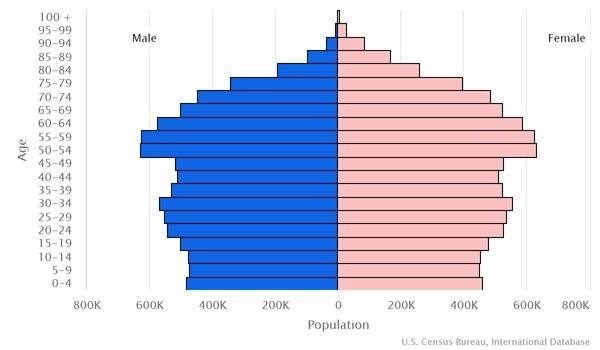
Dependency ratios
total dependency ratio: 54.9
youth dependency ratio: 24
elderly dependency ratio: 30.9
potential support ratio: 3.2 (2021 est.)
Median age
total: 42.8 years
male: 41.6 years
female: 44 years (2020 est.)
Population distribution
an area known as the Randstad, anchored by the cities of Amsterdam, Rotterdam, the Hague, and Utrecht, is the most densely populated region; the north tends to be less dense, though sizeable communities can be found throughout the entire country
Urbanization
urban population: 93.2% of total population (2023)
rate of urbanization: 0.59% annual rate of change (2020-25 est.)
Major urban areas - population
1.174 million AMSTERDAM (capital), 1.018 million Rotterdam (2023)
Sex ratio
at birth: 1.05 male(s)/female
0-14 years: 1.05 male(s)/female
15-24 years: 1.04 male(s)/female
25-54 years: 1.01 male(s)/female
55-64 years: 0.99 male(s)/female
65 years and over: 0.67 male(s)/female
total population: 0.98 male(s)/female (2022 est.)
Mother's mean age at first birth
30.2 years (2020 est.)
Maternal mortality ratio
5 deaths/100,000 live births (2017 est.)
country comparison to the world: 169Infant mortality rate
total: 3.4 deaths/1,000 live births
male: 3.76 deaths/1,000 live births
female: 3.02 deaths/1,000 live births (2022 est.)
Life expectancy at birth
total population: 82.16 years
male: 79.93 years
female: 84.49 years (2022 est.)
Contraceptive prevalence rate
73% (2013)
note: percent of women aged 18-45
Drinking water source
improved: urban: 100% of population
rural: 100% of population
total: 100% of population
unimproved: urban: 0% of population
rural: 0% of population
total: 0% of population (2020 est.)
Current health expenditure
10.1% of GDP (2019)
Physicians density
4.08 physicians/1,000 population (2020)
Hospital bed density
3.2 beds/1,000 population (2018)
Sanitation facility access
improved: urban: 100% of population
rural: 100% of population
total: 100% of population
unimproved: urban: 0% of population
rural: 0% of population
total: 0% of population (2020 est.)
Alcohol consumption per capita
total: 8.23 liters of pure alcohol (2019 est.)
beer: 3.95 liters of pure alcohol (2019 est.)
wine: 2.92 liters of pure alcohol (2019 est.)
spirits: 1.36 liters of pure alcohol (2019 est.)
other alcohols: 0 liters of pure alcohol (2019 est.)
Tobacco use
total: 22.2% (2020 est.)
male: 24.4% (2020 est.)
female: 19.9% (2020 est.)
Literacy
total population: NA
male: NA
female: NA
School life expectancy (primary to tertiary education)
total: 19 years
male: 18 years
female: 19 years (2020)
Youth unemployment rate (ages 15-24)
total: 9.3%
male: 9.7%
female: 9% (2021 est.)
Environment
Environment - current issues
water and air pollution are significant environmental problems; pollution of the country's rivers from industrial and agricultural chemicals, including heavy metals, organic compounds, nitrates, and phosphates; air pollution from vehicles and refining activities
Environment - international agreements
party to: Air Pollution, Air Pollution-Heavy Metals, Air Pollution-Multi-effect Protocol, Air Pollution-Nitrogen Oxides, Air Pollution-Persistent Organic Pollutants, Air Pollution-Sulphur 85, Air Pollution-Sulphur 94, Air Pollution-Volatile Organic Compounds, Antarctic-Environmental Protection, Antarctic-Marine Living Resources, Antarctic Treaty, Biodiversity, Climate Change, Climate Change-Kyoto Protocol, Climate Change-Paris Agreement, Comprehensive Nuclear Test Ban, Desertification, Endangered Species, Environmental Modification, Hazardous Wastes, Law of the Sea, Marine Dumping-London Convention, Marine Dumping-London Protocol, Marine Life Conservation, Nuclear Test Ban, Ozone Layer Protection, Ship Pollution, Tropical Timber 2006, Wetlands, Whaling
signed, but not ratified: none of the selected agreements
Air pollutants
particulate matter emissions: 12.07 micrograms per cubic meter (2016 est.)
carbon dioxide emissions: 170.78 megatons (2016 est.)
methane emissions: 17.79 megatons (2020 est.)
Climate
temperate; marine; cool summers and mild winters
Land use
agricultural land: 55.1% (2018 est.)
arable land: 29.8% (2018 est.)
permanent crops: 1.1% (2018 est.)
permanent pasture: 24.2% (2018 est.)
forest: 10.8% (2018 est.)
other: 34.1% (2018 est.)
Urbanization
urban population: 93.2% of total population (2023)
rate of urbanization: 0.59% annual rate of change (2020-25 est.)
Revenue from forest resources
forest revenues: 0.01% of GDP (2018 est.)
country comparison to the world: 155Waste and recycling
municipal solid waste generated annually: 8.855 million tons (2015 est.)
municipal solid waste recycled annually: 2,179,216 tons (2015 est.)
percent of municipal solid waste recycled: 24.6% (2015 est.)
Major rivers (by length in km)
Rhine river mouth (shared with Switzerland [s], Germany, and France) - 1,233 km
note – [s] after country name indicates river source; [m] after country name indicates river mouth
Major watersheds (area sq km)
Atlantic Ocean drainage: Rhine-Maas (198,735 sq km)
Total water withdrawal
municipal: 1.26 billion cubic meters (2017 est.)
industrial: 14.74 billion cubic meters (2017 est.)
agricultural: 76.5 million cubic meters (2017 est.)
Total renewable water resources
91 billion cubic meters (2017 est.)
Government
Country name
conventional long form: Kingdom of the Netherlands
conventional short form: Netherlands
local long form: Koninkrijk der Nederlanden
local short form: Nederland
abbreviation: NL
etymology: the country name literally means "the lowlands" and refers to the geographic features of the land being both flat and down river from higher areas (i.e., at the estuaries of the Scheldt, Meuse, and Rhine Rivers; only about half of the Netherlands is more than 1 meter above sea level)
Government type
parliamentary constitutional monarchy; part of the Kingdom of the Netherlands
Capital
name: Amsterdam; note - The Hague is the seat of government
geographic coordinates: 52 21 N, 4 55 E
time difference: UTC+1 (6 hours ahead of Washington, DC, during Standard Time)
daylight saving time: +1hr, begins last Sunday in March; ends last Sunday in October
time zone note: time descriptions apply to the continental Netherlands only, for the constituent countries in the Caribbean, the time difference is UTC-4
etymology: the original Dutch name, Amstellerdam, meaning "a dam on the Amstel River," dates to the 13th century; over time the name simplified to Amsterdam
Administrative divisions
12 provinces (provincies, singular - provincie), 3 public entities* (openbare lichamen, singular - openbaar lichaam (Dutch); entidatnan publiko, singular - entidat publiko (Papiamento)); Bonaire*, Drenthe, Flevoland, Fryslan (Friesland), Gelderland, Groningen, Limburg, Noord-Brabant (North Brabant), Noord-Holland (North Holland), Overijssel, Saba*, Sint Eustatius*, Utrecht, Zeeland (Zealand), Zuid-Holland (South Holland)
note 1: the Netherlands is one of four constituent countries of the Kingdom of the Netherlands; the other three, Aruba, Curacao, and Sint Maarten, are all islands in the Caribbean; while all four parts are considered equal partners, in practice, most of the Kingdom's affairs are administered by the Netherlands, which makes up about 98% of the Kingdom's total land area and population
note 2: although Bonaire, Saba, and Sint Eustatius are officially incorporated into the country of the Netherlands under the broad designation of "public entities," Dutch Government sources regularly apply to them the more descriptive term of "special municipalities"; Bonaire, Saba, and Sint Eustatius are collectively referred to as the Caribbean Netherlands
Independence
23 January 1579 (the northern provinces of the Low Countries conclude the Union of Utrecht breaking with Spain; on 26 July 1581, they formally declared their independence with an Act of Abjuration; however, it was not until 30 January 1648 and the Peace of Westphalia that Spain recognized this independence)
National holiday
King's Day (birthday of King WILLEM-ALEXANDER), 27 April (1967); note - King's or Queen's Day are observed on the ruling monarch's birthday; currently celebrated on 26 April if 27 April is a Sunday
Constitution
history: many previous to adoption of the "Basic Law of the Kingdom of the Netherlands" on 24 August 1815; revised 8 times, the latest in 1983
amendments: proposed as an Act of Parliament by or on behalf of the king or by the Second Chamber of the States General; the Second Chamber is dissolved after its first reading of the Act; passage requires a second reading by both the First Chamber and the newly elected Second Chamber, followed by at least two-thirds majority vote of both chambers, and ratification by the king; amended many times, last in 2018
Legal system
civil law system based on the French system; constitution does not permit judicial review of acts of the States General
International law organization participation
accepts compulsory ICJ jurisdiction with reservations; accepts ICCt jurisdiction
Citizenship
citizenship by birth: no
citizenship by descent only: at least one parent must be a citizen of the Netherlands
dual citizenship recognized: no
residency requirement for naturalization: 5 years
Suffrage
18 years of age; universal
Executive branch
chief of state: King WILLEM-ALEXANDER (since 30 April 2013); Heir Apparent Princess CATHARINA-AMALIA (daughter of King WILLEM-ALEXANDER, born 7 December 2003)
head of government: Prime Minister Mark RUTTE (since 14 October 2010); Deputy Prime Ministers Sigrid KAAG and Wopke HOEKSTRA (since 10 January 2022) and Carola SCHOUTEN (since 26 October 2017); note - Mark RUTTE heads his fourth cabinet
cabinet: Council of Ministers appointed by the monarch
elections/appointments: the monarchy is hereditary; following Second Chamber elections, the leader of the majority party or majority coalition is usually appointed prime minister by the monarch; deputy prime ministers are appointed by the monarch
Legislative branch
description: bicameral States General or Staten Generaal consists of:
Senate or Eerste Kamer (75 seats; members indirectly elected by the country's 12 provincial council members by proportional representation vote; members serve 4-year terms)
House of Representatives or Tweede Kamer (150 seats; members directly elected in multi-seat constituencies by open-list proportional representation vote to serve up to 4-year terms)
elections:
First Chamber - last held on 27 May 2019 (next to be held in May 2023)
Second Chamber - last held on 15-17 March 2021 (next to be held on 31 March 2025)
election results:
First Chamber - percent of vote by party - VVD 16%, CDA 12%, GL 10.7%, D66 9.3%, PvdA 8%, PVV 6.7%, SP 5.3%, CU 5.3%, PvdD 4%, SGP 2.7%, 50Plus 2.7%, FvD 1.3%, other 16%; seats by party - VVD 12, CDA 9, GL 8, D66 7, PvdA 6, PVV 5, SP 4, CU 4, PvdD 3, SGP 2, 50Plus 2, FvD 1, other 12; composition (as of September 2021) - men 52, women 23, percent of women 30.7%
Second Chamber - percent of vote by party - VVD 21.9%, D66 15%, PVV 10.8%, CDA 9.5%, SP 9.1%, PvdA 5.7%, GL 5.2%, FvD 5%, PvdD 3.8%, CU 3.4%, other 13.7%; seats by party - VVD 34, D66 24, PVV 17, CDA 15, GL 8, FvD 8, PvdD 6, PvdA 9, SP 9, CU 5, Denk 3, SGP 3, 50 Plus 1, other 6; composition (as of September 2021) - men 89, women 61, percent of women 40.7%; note - total States General percent of women 37.3%
Judicial branch
highest court(s): Supreme Court or Hoge Raad (consists of 41 judges: the president, 6 vice presidents, 31 justices or raadsheren, and 3 justices in exceptional service, referred to as buitengewone dienst); the court is divided into criminal, civil, tax, and ombuds chambers
judge selection and term of office: justices appointed by the monarch from a list provided by the Second Chamber of the States General; justices appointed for life or until mandatory retirement at age 70
subordinate courts: courts of appeal; district courts, each with up to 5 subdistrict courts; Netherlands Commercial Court
Political parties and leaders
Christian Democratic Appeal or CDA [Wopke HOEKSTRA]
Christian Union or CU [Gert-Jan SEGERS]
Democrats 66 or D66 [Sigrid KAAG]
Denk [Farid AZARKAN]
50Plus [Martin van ROOIJEN]
Forum for Democracy or FvD [Thierry BAUDET]
Green Left (GroenLinks) or GL [Jesse KLAVER]
Labor Party or PvdA (vacant)
Party for Freedom or PVV [Geert WILDERS]
Party for the Animals or PvdD [Esther OUWENHAND]
People's Party for Freedom and Democracy or VVD [Mark RUTTE]
Reformed Political Party or SGP [Kees VAN DER STAAIJ]
Socialist Party or SP [Lilian MARIJNISSEN]
International organization participation
ADB (nonregional member), AfDB (nonregional member), Arctic Council (observer), Australia Group, Benelux, BIS, CBSS (observer), CD, CE, CERN, EAPC, EBRD, ECB, EIB, EITI (implementing country), EMU, ESA, EU, FAO, FATF, G-10, IADB, IAEA, IBRD, ICAO, ICC (national committees), ICCt, ICRM, IDA, IEA, IFAD, IFC, IFRCS, IGAD (partners), IHO, ILO, IMF, IMO, IMSO, Interpol, IOC, IOM, IPU, ISO, ITSO, ITU, ITUC (NGOs), MIGA, MINUSMA, NATO, NEA, NSG, OAS (observer), OECD, OPCW, OSCE, Pacific Alliance (observer), Paris Club, PCA, Schengen Convention, SELEC (observer), UN, UNCTAD, UNDOF, UNESCO, UNHCR, UNHRC, UNIDO, UNMISS, UNRWA, UN Security Council (temporary), UNTSO, UNWTO, UPU, Wassenaar Arrangement, WCO, WHO, WIPO, WMO, WTO, ZC
Diplomatic representation in the US
chief of mission: Ambassador Andre HASPELS (since 16 September 2019)
chancery: 4200 Linnean Avenue NW, Washington, DC 20008
telephone: [1] (202) 244-5300
FAX: [1] (202) 362-3430
email address and website:
https://www.netherlandsworldwide.nl/countries/united-states/about-us/embassy-in-washington-dc
consulate(s) general: Atlanta, Chicago, Miami, New York, San Francisco
Diplomatic representation from the US
chief of mission: Ambassador (vacant); Charge d'Affaires Marja VERLOOP (since 17 January 2021)
embassy: John Adams Park 1, 2244 BZ Wassenaar
mailing address: 5780 Amsterdam Place, Washington DC 20521-5780
telephone: [31] (70) 310-2209
FAX: [31] (70) 310-2207
email address and website:
AmsterdamUSC@state.gov
https://nl.usembassy.gov/
consulate(s) general: Amsterdam
Flag description
three equal horizontal bands of red (bright vermilion; top), white, and blue (cobalt); similar to the flag of Luxembourg, which uses a lighter blue and is longer; the colors were derived from those of WILLIAM I, Prince of Orange, who led the Dutch Revolt against Spanish sovereignty in the latter half of the 16th century; originally the upper band was orange, but because its dye tended to turn red over time, the red shade was eventually made the permanent color; the banner is perhaps the oldest tricolor in continuous use
National symbol(s)
lion, tulip; national color: orange
National anthem
name: "Het Wilhelmus" (The William)
lyrics/music: Philips VAN MARNIX van Sint Aldegonde (presumed)/unknown
note: adopted 1932, in use since the 17th century, making it the oldest national anthem in the world; also known as "Wilhelmus van Nassouwe" (William of Nassau), it is in the form of an acrostic, where the first letter of each stanza spells the name of the leader of the Dutch Revolt
National heritage
total World Heritage Sites: 12 (11 cultural, 1 natural); note - includes one site in Curacao
selected World Heritage Site locales: Schokland and Surroundings (c); Dutch Water Defense Lines (c); Van Nellefabriek (c); Mill Network at Kinderdijk-Elshout (c); Droogmakerij de Beemster (Beemster Polder) (c); Rietveld Schröderhuis (Rietveld Schröder House) (c); Wadden Sea (n); Seventeenth Century Canal Ring Area of Amsterdam inside the Singelgracht (c); Colonies of Benevolence (c); Frontiers of the Roman Empire - The Lower German Limes (c)
Economy
Economic overview
The Netherlands, the sixth-largest economy in the European Union, plays an important role as a European transportation hub, with a consistently high trade surplus, stable industrial relations, and low unemployment. Industry focuses on food processing, chemicals, petroleum refining, and electrical machinery. A highly mechanized agricultural sector employs only 2% of the labor force but provides large surpluses for food-processing and underpins the country’s status as the world’s second largest agricultural exporter.
The Netherlands is part of the euro zone, and as such, its monetary policy is controlled by the European Central Bank. The Dutch financial sector is highly concentrated, with four commercial banks possessing over 80% of banking assets, and is four times the size of Dutch GDP.
In 2008, during the financial crisis, the government budget deficit hit 5.3% of GDP. Following a protracted recession from 2009 to 2013, during which unemployment doubled to 7.4% and household consumption contracted for four consecutive years, economic growth began inching forward in 2014. Since 2010, Prime Minister Mark RUTTE’s government has implemented significant austerity measures to improve public finances and has instituted broad structural reforms in key policy areas, including the labor market, the housing sector, the energy market, and the pension system. In 2017, the government budget returned to a surplus of 0.7% of GDP, with economic growth of 3.2%, and GDP per capita finally surpassed pre-crisis levels. The fiscal policy announced by the new government in the 2018-2021 coalition plans for increases in government consumption and public investment, fueling domestic demand and household consumption and investment. The new government’s policy also plans to increase demand for workers in the public and private sector, forecasting a further decline in the unemployment rate, which hit 4.8% in 2017.
Real GDP (purchasing power parity)
$945.48 billion (2020 est.)
$982.22 billion (2019 est.)
$966.02 billion (2018 est.)
note: data are in 2017 dollars
Real GDP growth rate
1.63% (2019 est.)
2.32% (2018 est.)
3.02% (2017 est.)
Real GDP per capita
$54,200 (2020 est.)
$56,600 (2019 est.)
$56,100 (2018 est.)
note: data are in 2017 dollars
GDP (official exchange rate)
$907.042 billion (2019 est.)
Inflation rate (consumer prices)
2.6% (2019 est.)
1.7% (2018 est.)
1.3% (2017 est.)
Credit ratings
Fitch rating: AAA (1994)
Moody's rating: Aaa (1986)
Standard & Poors rating: AAA (2015)
note: The year refers to the year in which the current credit rating was first obtained.
GDP - composition, by sector of origin
agriculture: 1.6% (2017 est.)
industry: 17.9% (2017 est.)
services: 70.2% (2017 est.)
GDP - composition, by end use
household consumption: 44.3% (2017 est.)
government consumption: 24.2% (2017 est.)
investment in fixed capital: 20.5% (2017 est.)
investment in inventories: 0.2% (2017 est.)
exports of goods and services: 83% (2017 est.)
imports of goods and services: -72.3% (2017 est.)
Agricultural products
milk, potatoes, sugar beet, pork, onions, wheat, poultry, tomatoes, carrots/turnips, beef
Industries
agroindustries, metal and engineering products, electrical machinery and equipment, chemicals, petroleum, construction, microelectronics, fishing
Labor force - by occupation
agriculture: 1.2%
industry: 17.2%
services: 81.6% (2015 est.)
Youth unemployment rate (ages 15-24)
total: 9.3%
male: 9.7%
female: 9% (2021 est.)
Population below poverty line
13.6% (2019 est.)
Gini Index coefficient - distribution of family income
28.5 (2017 est.)
25.1 (2013 est.)
Household income or consumption by percentage share
lowest 10%: 2.3%
highest 10%: 24.9% (2014 est.)
Budget
revenues: 361.4 billion (2017 est.)
expenditures: 352.4 billion (2017 est.)
Public debt
56.5% of GDP (2017 est.)
61.3% of GDP (2016 est.)
note: data cover general government debt and include debt instruments issued (or owned) by government entities other than the treasury; the data include treasury debt held by foreign entities; the data include debt issued by subnational entities, as well as intragovernmental debt; intragovernmental debt consists of treasury borrowings from surpluses in the social funds, such as for retirement, medical care, and unemployment, debt instruments for the social funds are not sold at public auctions
Fiscal year
calendar year
Current account balance
$90.207 billion (2019 est.)
$98.981 billion (2018 est.)
Exports
$719.78 billion (2020 est.) note: data are in current year dollars
$755.77 billion (2019 est.) note: data are in current year dollars
$773.74 billion (2018 est.) note: data are in current year dollars
Exports - partners
Germany 20%, Belgium 12%, United Kingdom 9%, France 7%, United States 5% (2019)
Exports - commodities
refined petroleum, packaged medicines, broadcasting equipment, photography equipment, computers (2019)
Imports
$622.66 billion (2020 est.) note: data are in current year dollars
$661.18 billion (2019 est.) note: data are in current year dollars
$677.38 billion (2018 est.) note: data are in current year dollars
Imports - partners
Germany 15%, China 11%, Belgium 9%, United States 8%, Russia 7%, United Kingdom 5% (2019)
Imports - commodities
crude petroleum, refined petroleum, broadcasting equipment, computers, cars (2019)
Reserves of foreign exchange and gold
$38.44 billion (31 December 2017 est.)
$38.21 billion (31 December 2015 est.)
Debt - external
$4,345,413,000,000 (2019 est.)
$4,625,016,000,000 (2018 est.)
Exchange rates
euros (EUR) per US dollar -
0.82771 (2020 est.)
0.90338 (2019 est.)
0.87789 (2018 est.)
0.885 (2014 est.)
0.7634 (2013 est.)
Energy
Electricity access
electrification - total population: 100% (2020)
Electricity
installed generating capacity: 43.409 million kW (2020 est.)
consumption: 109.796 billion kWh (2020 est.)
exports: 22.433 billion kWh (2020 est.)
imports: 19.773 billion kWh (2020 est.)
transmission/distribution losses: 5.059 billion kWh (2020 est.)
Electricity generation sources
fossil fuels: 68.3% of total installed capacity (2020 est.)
nuclear: 3.3% of total installed capacity (2020 est.)
solar: 6.8% of total installed capacity (2020 est.)
wind: 13.1% of total installed capacity (2020 est.)
hydroelectricity: 0% of total installed capacity (2020 est.)
tide and wave: 0% of total installed capacity (2020 est.)
geothermal: 0% of total installed capacity (2020 est.)
biomass and waste: 8.5% of total installed capacity (2020 est.)
Coal
production: 1.879 million metric tons (2020 est.)
consumption: 8.241 million metric tons (2020 est.)
exports: 20.164 million metric tons (2020 est.)
imports: 21.552 million metric tons (2020 est.)
proven reserves: 497 million metric tons (2019 est.)
Petroleum
total petroleum production: 76,100 bbl/day (2021 est.)
refined petroleum consumption: 915,200 bbl/day (2019 est.)
crude oil and lease condensate exports: 8,800 bbl/day (2018 est.)
crude oil and lease condensate imports: 1,096,500 bbl/day (2018 est.)
crude oil estimated reserves: 137.7 million barrels (2021 est.)
Refined petroleum products - production
1.282 million bbl/day (2017 est.)
country comparison to the world: 17Refined petroleum products - exports
2.406 million bbl/day (2017 est.)
country comparison to the world: 3Refined petroleum products - imports
2.148 million bbl/day (2017 est.)
country comparison to the world: 3Natural gas
production: 32,857,597,000 cubic meters (2019 est.)
consumption: 44,752,918,000 cubic meters (2019 est.)
exports: 42,827,461,000 cubic meters (2019 est.)
imports: 55,767,276,000 cubic meters (2019 est.)
proven reserves: 132.608 billion cubic meters (2021 est.)
Carbon dioxide emissions
214.416 million metric tonnes of CO2 (2019 est.)
from coal and metallurgical coke: 23.15 million metric tonnes of CO2 (2019 est.)
from petroleum and other liquids: 116.24 million metric tonnes of CO2 (2019 est.)
from consumed natural gas: 75.027 million metric tonnes of CO2 (2019 est.)
Energy consumption per capita
219.606 million Btu/person (2019 est.)
country comparison to the world: 19Communications
Telephones - fixed lines
total subscriptions: 4.937 million (2020 est.)
subscriptions per 100 inhabitants: 29 (2020 est.)
Telephones - mobile cellular
total subscriptions: 21.415 million (2020 est.)
subscriptions per 100 inhabitants: 125 (2020 est.)
Telecommunication systems
general assessment: telecom infrastructure in the Netherlands continues to be upgraded as modernization schemes undertaken by telcos make steady progress; other fiber providers have been supported by regulatory measures which have encouraged municipal governments to intervene with telcos’ fiber builds, facilitating open access networks in a bid to make rollouts cheaper, and completed sooner; while the Mobile Network Operators (MNOs) are also closing down their Global System for Mobile Communication (MSM) and 3G networks and repurposing their spectrum and physical assets for LTE and 5G, the regulator has also encouraged GSM/3G roaming in the interim, thus safeguarding services such as machine to machine and other low data-use applications while individual MNOs disable their own GSM/3G networks; the country has one of the highest fixed broadband penetration rates in the world, with effective cross-platform competition between Digital Subscriber Line (DSL), Hybrid Fiber Coazial (HFC), and fiber networks; in the third quarter of 2020 the number of cable broadband connections fell for the first time, while the DSL segment has long been eclipsed by fiber; by the end of 2021, over a quarter of fixed broadband connections were on fiber infrastructure, while DSL accounted for only about 29%; almost 49% of fixed connections provided data above 100Mb/s, while an additional 43.7% provided data of at least 30Mb/s (2022)
domestic: extensive fixed-line, fiber-optic network; large cellular telephone system with five major operators utilizing the third generation of the Global System for Mobile Communications technology; one in five households now use Voice over the Internet Protocol services; fixed-line nearly 29 per 100 and mobile-cellular at 125 per 100 persons (2020)
international: country code - 31; landing points for Farland North, TAT-14, Circe North, Concerto, Ulysses 2, AC-1, UK-Netherlands 14, and COBRAcable submarine cables which provide links to the US and Europe; satellite earth stations - 5 (3 Intelsat - 1 Indian Ocean and 2 Atlantic Ocean, 1 Eutelsat, and 1 Inmarsat) (2019)
note: the COVID-19 pandemic continues to have a significant impact on production and supply chains globally; since 2020, some aspects of the telecom sector have experienced a downturn, particularly in mobile device production; progress toward 5G implementation has resumed, as well as upgrades to infrastructure; consumer spending on telecom services has increased due to the surge in demand for capacity and bandwidth; the crucial nature of telecom services as a tool for work and school from home is still evident, and the spike in this area has seen growth opportunities for development of new tools and increased services
Broadcast media
more than 90% of households are connected to cable or satellite TV systems that provide a wide range of domestic and foreign channels; public service broadcast system includes multiple broadcasters, 3 with a national reach and the remainder operating in regional and local markets; 2 major nationwide commercial television companies, each with 3 or more stations, and many commercial TV stations in regional and local markets; nearly 600 radio stations with a mix of public and private stations providing national or regional coverage
Internet users
total: 15,871,765 (2020 est.)
percent of population: 91% (2020 est.)
Broadband - fixed subscriptions
total: 7,525,016 (2020 est.)
subscriptions per 100 inhabitants: 44 (2020 est.)
Transportation
National air transport system
number of registered air carriers: 8 (2020)
inventory of registered aircraft operated by air carriers: 238
annual passenger traffic on registered air carriers: 43,996,044 (2018)
annual freight traffic on registered air carriers: 5,886,510,000 (2018) mt-km
Airports - with paved runways
total: 23
over 3,047 m: 3
2,438 to 3,047 m: 11
1,524 to 2,437 m: 1
914 to 1,523 m: 6
under 914 m: 2 (2021)
Airports - with unpaved runways
total: 6
914 to 1,523 m: 4
under 914 m: 2 (2021)
Heliports
1 (2021)
Pipelines
14,000 km gas, 2,500 km oil and refined products, 3,000 km chemicals (2017)
Railways
total: 3,058 km (2016)
standard gauge: 3,058 km (2016) 1.435-m gauge (2,314 km electrified)
Roadways
total: 139,124 km (2016) (includes 3,654 km of expressways)
country comparison to the world: 37Merchant marine
total: 1,199
by type: bulk carrier 10, container ship 40, general cargo 559, oil tanker 26, other 564 (2021)
Ports and terminals
major seaport(s): IJmuiden, Vlissingen
container port(s) (TEUs): Rotterdam (14,810,804) (2019)
LNG terminal(s) (import): Gate (Rotterdam)
river port(s): Amsterdam (Nordsee Kanaal); Moerdijk (Hollands Diep River); Rotterdam (Rhine River); Terneuzen (Western Scheldt River)
Military and Security
Military and security forces
Netherlands (Dutch) Armed Forces (Nederlandse Krijgsmacht): Royal Netherlands Army, Royal Netherlands Navy (includes Naval Air Service and Marine Corps), Royal Netherlands Air Force, Royal Netherlands Marechaussee (Military Constabulary) (2022)
note: the Netherlands Coast Guard and the Dutch Caribbean Coast Guard are civilian in nature but managed by the Royal Netherlands Navy
Military expenditures
1.7% of GDP (2022 est.)
1.5% of GDP (2021)
1.4% of GDP (2020)
1.3% of GDP (2019) (approximately $13.6 billion)
1.2% of GDP (2018) (approximately $12.3 billion)
Military and security service personnel strengths
approximately 40,000 active duty personnel (20,000 Army; 7,500 Navy; 6,500 Air Force; 6,000 Constabulary) (2022)
note: the Navy includes about 2,300 marines
Military equipment inventories and acquisitions
the military's inventory consists of a mix of domestically-produced and modern European- and US-sourced equipment; since 2010, the US has been the leading supplier of weapons systems to the Netherlands; the Netherlands has an advanced domestic defense industry that focuses on armored vehicles, naval ships, and air defense systems; it also participates with the US and other European countries on joint development and production of advanced weapons systems (2021)
Military service age and obligation
17 years of age for voluntary service for men and women; the military is an all-volunteer force; conscription remains in place, but the requirement to show up for compulsory military service was suspended in 1997; must be a citizen of the Netherlands (2022)
note: in 2019, women made up about 11% of the military's full-time personnel
Military deployments
270 Lithuania (NATO); 125 Slovakia (NATO) (2022)
note: in response to Russia’s 2022 invasion of Ukraine, some NATO countries, including the Netherlands, have sent additional troops and equipment to the battlegroups deployed in NATO territory in eastern Europe
Military - note
the Netherlands is a member of NATO and was one of the original 12 countries to sign the North Atlantic Treaty (also known as the Washington Treaty) in 1949
since 1973, the Dutch Marine Corps has worked closely with the British Royal Marines, including jointly in the UK-Netherlands amphibious landing force; a Dutch Army airmobile infantry brigade and a mechanized infantry brigade have been integrated into the German Army since 2014 and 2016 respectively
in 2020, Belgium, Denmark, and the Netherlands formed a joint Composite Special Operations Component Command (C-SOCC); in 2015, Belgium, the Netherlands, and Luxembourg signed an agreement to conduct joint air policing of their territories; under the agreement, which went into effect in January of 2017, the Belgian and Dutch Air Forces trade responsibility for patrolling the skies over the three countries (2022)
Terrorism
Terrorist group(s)
Islamic State of Iraq and ash-Sham (ISIS)
note: details about the history, aims, leadership, organization, areas of operation, tactics, targets, weapons, size, and sources of support of the group(s) appear(s) in Appendix-T
Transnational Issues
Disputes - international
none identified
Refugees and internally displaced persons
refugees (country of origin): 37,792 (Syria), 14,787 (Eritrea), 8,368 (Somalia), 6,636 (Iraq), 5,346 (Iran) (mid-year 2021); 79,250 (Ukraine) (as of 30 September 2022)
stateless persons: 2,087 (mid-year 2021)
Illicit drugs
a significant transit country for illicit drugs, especially cocaine from South America destined for Europe; one of the largest sources of synthetic drugs for international markets; numerous methamphetamine laboratories; traffickers use postage companies to send cocaine, ecstasy or methamphetamines to global customers
